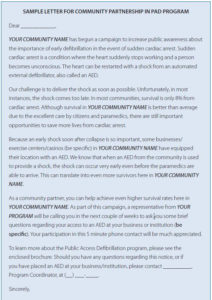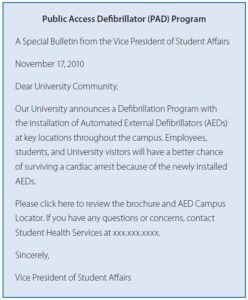Talking Points and Facts
To begin a PAD program, EMS leaders should inform the community about cardiac arrest survival rates and goals for improving survival.
Successful PAD programs include:
- EMS leadership
- Community support
- Designated responders
- Prominent placement
- Clear signage
- Registration with EMS
- Public education
Examples of successful programs can be seen at airports across the country.
Advocates should stress the importance of bystander CPR and early defibrillation with an AED while awaiting the arrival of EMS. Time is of the essence as each minute of delay in treatment represents a major drop in the chance of survival. Promoters should teach citizens to find an AED and provide a shock while waiting for EMS to arrive.
In the U.S. and Canada, the public uses an AED for only about 2-5% of the arrests they witness. Since 20-25% of cardiac arrests happen in public places, widespread PAD programs will make a significant difference in overall survival rates.
The price of an AED ranges from about $1,500 to $2,000. Pads are about $50 and last 2 years. Batteries are about $100 and last 1 to 5 years. Wall mounts cost an additional $200 to $500. Many specialty businesses now exist to place and maintain AEDs for a fee.
Letter of Support for Participating in the Community PAD Program
PAD programs are generally administered in cooperation with local EMS oversight. Community members can advocate for the implementation of an organized program in their communities. See the letter of support sample.
Brochure
A generic brochure for use to encourage community buy-in and site participation is very useful and can be tailored to meet your community’s needs. An example of a PAD program brochure developed for the community by a local woman’s club can be found at www.heartrescueproject.com.
Registration Postcard
A postcard or website can be used to encourage lay persons to report the location of any community based AEDs. Location reporting can often assist local EMS systems in notifying a 911 caller of a nearby AED and can help in determining where to place additional AEDs in the community. It is believed that the locations of a majority of the AEDs in a community are unknown.18 An email or postcard can remind participants to replace batteries and pads before expiration and can request updated information on AED locations and any new AEDs that may have been added.
Community Training
AEDs are easy to use by simply following the voice prompts. Citizens needs to know how to recognize cardiac arrest, call 911, and to retrieve the device, turn it on, follow directions and place pads. AED training does not have to be formal or lengthy. Alternative methods to traditional classroom training are available. Your local EMS medical director will be able to help you locate appropriate training resources.
Registration of the AED Devices
Any AEDs placed in a community should be reported to the local EMS system, regardless of lack of a requirement to do so. By placing an AED in your community, you are partnering with your EMS agency. That agency can provide you with guidance, as needed. As 911 dispatch systems continue to evolve, technology will allow dispatchers to direct bystanders to a nearby AED while waiting for EMS to arrive. This approach only works if the 911 center knows where the AEDs are.
AEDs are sophisticated devices with built in safety measures to ensure that the device will not shock anyone unless they need it. The sophistication extends to the devices ability to capture and store event data, which may be useful to healthcare providers as well as the patient. Your local EMS providers may wish to capture information from the AED following its use.
Placement
AEDs can be most effective when placed in an area with a large concentration of individuals. One guideline suggests an AED be present if more than 250 people spend at least 8 hours a day at the site. Some very common places include: airports, shopping malls, public sports stadiums or arenas, public transportation locations (train, bus station, ferry terminal), health clubs, gyms, community centers, golf courses, tennis courts, and large industrial sites. Effective placement of AEDs will allow the rescuer to retrieve the machine and deliver a shock to a victim within 3 minutes of collapse. When deciding where to place AEDs, use this 3 minute rule as a guideline to help you determine how many AEDs you need and where to place them.
Companies should determine if there are places on-site where the incidence of sudden cardiac arrest may be higher, such as corporate health clubs, and identify locations that are hard to reach quickly. These may be good locations for AEDs. Areas where many people gather, such as cafeterias, often make sensible locations for the devices. It is imperative, when at all possible, to place AEDs within plain view in any unsecured location. Often used hallways and near elevators or building entrances are common locations.
AEDs should never be locked or placed out of sight. Giant Eagle foodstores, located throughout the Midwest, have an AED available at their customer service counters.
The Neighborhood Watch Model
Several communities around the country have established their own neighborhood PAD programs. Naperville, IL is one community that is exploring the installation of AEDs at the 24 neighborhood level. City officials say they’re working with the Naperville Area Homeowners Confederation to promote the installation of automated external defibrillators in residential neighborhoods throughout the city. Many neighborhoods have a central location well known to residents, such as a small park, which could make a sensible location for the placement of a neighborhood AED.
Signage
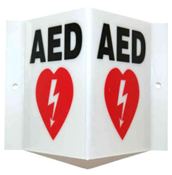 While most of America is more familiar with the red AED sign, recently, the International Liaison Committee on Resuscitation (ILCOR) has approved a bright green universal sign indicating the presence of an automated external defibrillator. There is also a red version of this newer logo designed for use in North America.
While most of America is more familiar with the red AED sign, recently, the International Liaison Committee on Resuscitation (ILCOR) has approved a bright green universal sign indicating the presence of an automated external defibrillator. There is also a red version of this newer logo designed for use in North America.
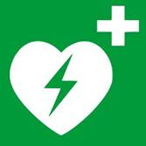 Both signs are intended to indicate the presence of an AED, the location of an AED in a room, a container with an AED for public use, or to indicate the direction to follow in order to reach the AED.
Both signs are intended to indicate the presence of an AED, the location of an AED in a room, a container with an AED for public use, or to indicate the direction to follow in order to reach the AED.
Incentives
Committed community groups, citizens, or business owners can implement an AED matching program. When equipping their own locations, business owners could donate an extra defibrillator to a local group such as a church or small business. Community service clubs may wish to participate and/or partner in this type of program to improve SCA survival in the local community.
Good Samaritan laws
Good Samaritan laws can protect those who use an AED to help a victim. These laws are intended to reduce a bystander’s hesitation to act for fear of being prosecuted for unintentional injury. These laws vary by area, but there are three elements that make up the Good Samaritan doctrine: (1) the care given was performed as the result of the emergency, (2) the initial emergency was not caused by the person providing assistance, and (3) the care was not given in a grossly negligent or reckless manner.
Good Samaritan laws vary by jurisdiction, but all 50 states and the District of Columbia have enacted some form of the Good Samaritan law.
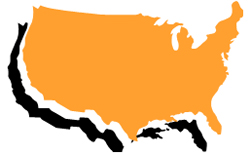 In addition to the Good Samaritan doctrine, states also have AED Laws which can serve to empower people to train and be prepared to use an automated external defibrillator to save lives. State legislation and mandates may exist for installing automated external defibrillators in public places like schools, sports stadiums, shopping malls, airports, and hotels.
In addition to the Good Samaritan doctrine, states also have AED Laws which can serve to empower people to train and be prepared to use an automated external defibrillator to save lives. State legislation and mandates may exist for installing automated external defibrillators in public places like schools, sports stadiums, shopping malls, airports, and hotels.
You can check on laws related to AED use in your state using either of the following sites:
FACTS
In the U.S. and Canada it is estimated that the public uses AEDs for about 2-5% of the arrests they witness. Based on estimates from communities with data, it is believed that public access defibrillation, even used only 2- 5% of the time, has saved about 474 lives per year in the U.S. and Canada.5


